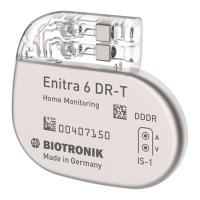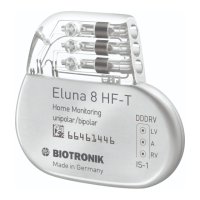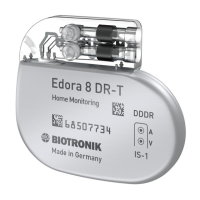Do you have a question about the BIOTRONIK Enitra 8 DR-T and is the answer not in the manual?
Specifies the intended use of the Enitra pacemaker family for bradycardia indications.
Describes the therapy management system for automatic data transmission and evaluation.
Describes sensing, pacing thresholds, capture control, and timing functions for pacing.
Details functions for resynchronizing ventricles and automatic capture control.
Provides general caution regarding cardiac electrotherapy and necessary precautionary measures.
Covers common complications like fluid accumulation, infections, tissue reactions, and therapy efficacy.
Discusses risks from external electrical current, diathermic procedures, and external defibrillation.
Emphasizes readiness of defibrillator, proper unpacking, and checking parts for damage.
Details connecting leads, using the programming head, and the auto-initialization process.
Precautions for checking device systems, performing tests, and continuously monitoring the patient.
Guidelines on not interrupting telemetry and procedures for cancelling telemetry.
Advice on avoiding critical settings, manual polarity, sensing, and sensitivity adjustments.
Lists functions to prevent device-induced complications, atrial tachycardia, and phrenic nerve stimulation.
Discusses risks of LV pacing, lead dislodgement, and recognizing lead failure.
Specifies follow-up intervals, use of Home Monitoring, and programmer-based follow-up.
Explains replacement indications, ERI activation, display, rate decrease, and deactivated functions.
Provides information on expected service times and magnet response after reaching ERI.
Details explantation, device replacement, cremation, and environmentally safe disposal of explants.
Covers basic rate, night rate, rate hystereses, AV delay, and AV hysteresis.
Covers pulse amplitude, pulse width, sensitivity, and capture control parameters.
Provides battery characteristics, service time calculations, and data from manufacturers.
| Brand | BIOTRONIK |
|---|---|
| Model | Enitra 8 DR-T |
| Category | Medical Equipment |
| Language | English |












